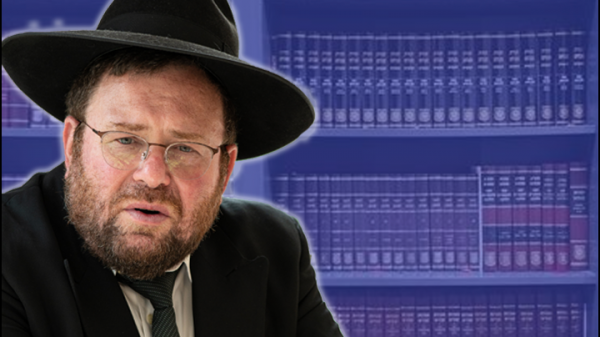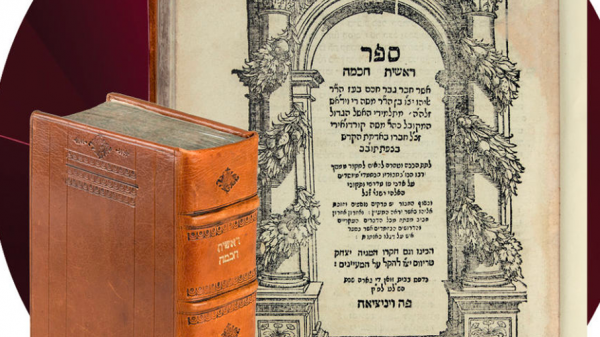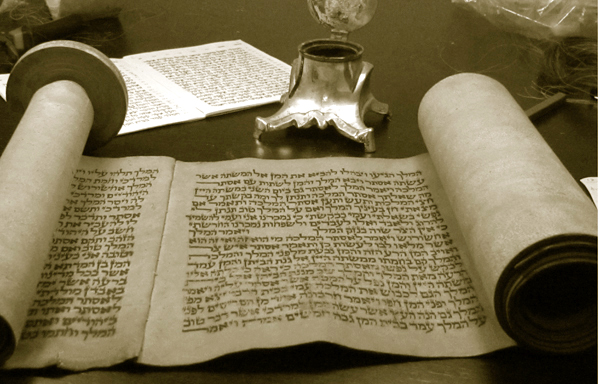Click here to download PDF
Why Delay the inevitable?
At the end of this week’s Parsha, we have the Korbanos for “Atzeres”. Rashi brings from the Chazal that “Atzeres” is from the word “atzor”- stop; That Hashem is telling the Jewish people “after the joyous days of Succos, it is hard for Me to bear your separation, stop and stay one more day”. Since the separation is inevitable, what does staying one more day accomplish? Seemingly it will only make things harder….
Shavuos & Shemini Atzeres
The Torah called this holiday “Atzeres”. Chazal borrowed this term for Shavuos. Whenever we find the term “Atzeres” in Chazal, they are talking about Shavuos, unless they specify that they are talking about Shemini Atzeres. Why did Chazal “steal” the name of (Shemini) Atzeres to make it the name of Shavuos? There is a link between these two holidays that needs to be explored. Shavuos is the holiday of the giving of the Torah. On Shemini Atzeres we celebrate Simchas HaTorah, the joy of the Torah. There are two questions here. Shouldn’t the “joy of the Torah” be reserved for the day when the Torah was given? Another point to ponder is that seemingly we rejoice in the Torah because we finished the annual cycle of the “leining” of the Chamisha Chumshei Torah. But this was not always the case everywhere. There was an ancient custom in Israel to finish the Chumash once every three years. Did they not have an annual Simchas Torah on Shemini Atzeres? More fundamentally, we go through the Chumash Parsha by Parsha, Shabbos by Shabbos. Why did we choose to finish the Chumash on the Yom tov of Shemini Atzeres and not on the Shabbos following Succos? (According to the custom of completing the Chumash once every three years, they fulfilled the institution of Ezra of reading the ‘tochacha’ of Bechukosai before Shavuos and the ‘tochacha’ of Ki Savo before Rosh HaShana (Megillah 31B), as a supplementary reading. It was the Maftir of those Shabbosos before those holidays).
Serving Leftovers?!?
The Midrash Rabba in this week’s Parsha (21:22) in explaining why the Korban Mussaf of Shemini Atzeres is so much smaller than the Korban Mussaf of even the last day of Succos gives a metaphor: “A king gave a feast for all his countrymen for 7 days. When the party was over, he said to his best friend “we finished with everyone, let’s party on whatever we can find. One vegetable here, one piece of meat or fish there.” So also, during Succos, the Korban Mussaf is massive, corresponding to all the nations of the world (who in the future will indeed ascend to Yerushalayim to celebrate Succos) and during that time, there is a massive amount of Korbanos offered corresponding to the huge feast for all. After the 7th day, that party is over and the small quantity of Korbanos on the 8th day represents all that could be found after the party is over. This metaphor is very difficult to understand. Why would the king want to serve his best friend “leftovers”? Furthermore, the Jewish people are not serving Hashem “leftovers” from what they sacrificed parallel to the seventy nations. How are the metaphor and the application symmetrical?
Total Exoneration
As we know, there is another theme that is in the background of the days of Succos. On Rosh Hashana and Yom Kippur, we were in judgment. Who were the prosecutors? The ministering angels of the nations of the world are on the “special counsel” that criticize us. The Midrash Rabba in Parshas Emor says that the sign that we won our case is when we emerge on the first day of Succos with our Lulav in hand. However, we still have to strive for “total exoneration” from any claims that the nations of the world have against us and that is, in the backdrop of our davening: “Hoshana” – Hashem save us! On Hoshana Raba is the great salvation where we are actually declared “totally exonerated”. Asides from prosecuting us for whatever we have done wrong, there is also the issue of whether we do our Mitzvos as well as they do theirs. The Gemara in Avoda Zara (3A) says that in the future Hashem will test the goyim with the Mitzvah of Succa and see how they cope with it. Ultimately, at the end of time our Mitzvos will be compared to theirs, as the Gemara (Avoda Zara 4B) says: “said Rabi Yehoshua ben Levi, all the Mitzvos that the Jewish people do are destined to hit the goyim in the face” as it says (Devarim 4:6): “observe them and keep them for it is your wisdom and your understanding to the eyes of the nations”. What does this cryptic statement mean? What does it mean that the wisdom and understanding of the Mitzvos hits the goyim between the eyes?
Torah vs Mitzvos
In the past we have raised the fundamental question of why a grand ceremony of the “giving of the Torah” was necessary. Tzaddikim such as Noach and Avraham were able to figure out or have the entirety of Torah revealed to them, even before it was “given”. As we’ve discussed in the past, the special quality of the giving of the Torah was that we actually got the essence of the Torah -The Torah in of itself. The tzaddikim who lived before Matan Torah were able to get ‘inside information’ as to what the Torah, in the highest place in Heaven, at the point of origin of created reality, says. The Jewish people at ‘Matan Torah’ got that Divine power in of itself. It was no longer just Hashem’s will and wisdom; it also became “our wisdom and our understanding”. Now the Torah is contained, interpreted, and extrapolated by the Jewish mind. Herein lays a fundamental difference between Torah study and Mitzvos observance. With Mitzvos, we are obeying with our bodies commands that come from the Torah. When we learn Torah, we are actually absorbing the Divine light of Hashem’s will and wisdom. So much so that the Yerushalmi says on the Mishna in Pe’ah “Talmud Torah k’neged kulam” – Torah study is parallel to all the Mitzvos. Says the Yerushalmi, “all the Mitzvos together do not measure up to even one word of Torah”. With this we can understand the Gemara in Sota (21A) that brings the Pasuk from Mishlei “Ki ner mitzvah v’Torah ohr” – Mitzvos are a candle and the Torah is light: “A candle only shines temporarily. So also, the merit of a Mitzvah only protects a person temporarily, but the merit of Torah that is light itself that shines forever, protects forever”. The Torah is pure Divine light, the essence of which was gifted to us with the giving of the Torah. Whereas Mitzvos are acts of obedience to conduct our earthly bodily affairs in this world in accordance with Torah law as a physical candle is to carry light. With this we can understand what the Gemara (Avoda Zara 4B) says regarding Mitzvos “today to do them and tomorrow to receive their reward” – “today to do them but not tomorrow to do them”. There are no Mitzvos in Olam HaBa. Even in this world, when a person dies, he is already “free of Mitzvos” (Shabbos 30A). However, this is not true for Torah as in Olam HaBa the “Aura of the Shechina” that the Tzaddikim enjoy are deeper revelations of the eternal light of Torah and in this world the Tzaddikim who have departed do not do Mitzvos in “Gan Eden” – the soul world, but they do learn Torah. Mitzvos are done with the body within time and space and that is the opportunity to do them and when time and space of life in this world is over, Mitzvos are non-applicable.
The Candle & The Light
The relationship between Torah and Mitzvos is a complex one. The Nefesh Hachaim (Shaar 4) explains using the candle/light analogy of the Gemara in Sota quoted above, to explain as follows: The candle has no light of its own, it has to be lit from a light source. The Mitzvos that are compared to candles need to be lit and their light source is the Torah that commanded them. Whatever Divine light that shines as a result of the Mitzvah comes from the Pasuk and the passages in Torah sheba’al Peh that command and lay out the details of that Mitzvah. Just like the unlit candle is a dark piece of wax, so also the Mitzvah would not have any spiritual value if not for the words of Torah commanding and explaining it. This is the secret of how Mitzvos that are physical actions done within time and space can earn unlimited eternal reward. How does a physical action produce such power? Because the Mitzvos are carrying the words of Torah which are of infinite, eternal power.
The Rambam’s position
With this we could understand the position of the Rambam (Hilchos Melachim 8:11) that qualifies that what Chazal say that “Chasidei Umos Haolam” – the righteous of the nations of the world have a portion in the world to come, is only if they did their seven Mitzvos out of the conviction that the Torah commanded them and Moshe made humanity aware that they were commanded in those Mitzvos. If they keep the Mitzvos without that conviction they are not considered the righteous who have a portion in the world to come, but rather just “wise ethical men”, which means that their seven Mitzvos will not earn them any Olam HaBa. Mitzvos are only worth Olam HaBa for Jew and Goy alike because of their connection to the Torah.
Jew vs Goy
There is a difference between our relationship to Torah and the goyim’s relationship to the Torah. The Torah which in essence is ours, also commands the goyim in their seven Mitzvos but they do not have the essence of the Torah. The goyim do not have the authority to assemble a Sanhedrin to interpret the Torah. The interpretation of the Torah lays solely by the Jewish people. They can and are obligated to set up courts and judges to enforce the law and to judge based on codified law, but to interpret the law is the unique role of the Jewish people alone. The Ramchal in the Daas Tevunos explains that this is the meaning behind “greater is he who is commanded to do the mitzva and does it than one who does it voluntarily”. This is seemingly counter-intuitive. Explains the Ramchal: the one who was commanded is the one that the Torah was actually speaking to when commanding the Mitzvah and therefore, he who is commanded to do has more Torah in his actions and makes a greater cosmic difference with his Mitzvah because he is working with the power of the Torah that specifically commanded him to do it. The one who is exempt from the Mitzvah accomplishes less cosmically because the Torah didn’t actually command him to do the Mitzvah, so he has less power of the Torah in this mitzvah that he did voluntarily.
This Ramchal could give another context to what the Nefesh haChaim writes (shaar Alef) that we with our Mitzvos are making a cosmic difference that realigns reality. Whereas, the goyim with their Mitzvos do not affect the cosmos. The Nefesh HaChaim himself explains the mechanics for the difference as a difference between the Jewish soul and the souls of the goyim. Our souls reach heavenwards to the very core of reality and therefore our Mitzvos reverberate up there and theirs do not. With the Ramchal we could explain the phenomenon from an additional angle (to which the Nefesh HaChaim would surely agree to, based on what he writes in Shaar Dalet). The power of the Mitzvos comes from the Torah, we have the essence of the Torah in the Mitzvos that we do, amplifying their power. They do not have the essence of the Torah in their Mitzvos. They are just obeying what our Torah commanded them to do. Just like our Mitzvos have greater cosmic power, so also our reward for doing them is much greater. With this we can understand what the Ramchal writes in the Derech Hashem (section 2, chapter 4) that even the righteous goyim that have earned Olam HaBa for themselves, are not full-fledged citizens of Olam HaBa but rather appendages to the Jewish people who are the prime citizens of Olam HaBa.
In their Face
With all this in mind we can appreciate how the statement of Rabi Yehoshua ben Levi that our Mitzvos will hit the goyim between the eyes because the Pasuk says, “it is your wisdom and understanding to the eyes of the nations”. The goyim claim to do better than we do because even if they were commanded in less Mitzvos, they are still billions more of them than us, so they argue that quantitatively they do far more good than we do. The message that will be ‘shoved in their face’ for them to see is that all their Mitzvos together don’t come close to the power of the Mitzvos of the Jewish people because we have the wisdom and the understanding and the wisdom of Torah within our Mitzvos, making them of infinite power, whereas they do not have “the wisdom and understanding of Torah” within their Mitzvos, making them finite by comparison.
Before & After the Golden Calf
The Gemara says in Nedarim (38A) that Hashem told Moshe following the sin of the golden calf, ‘write for yourself (singular) these words (shemos 34:27)’ that Hashem gave pilpula shel Torah- the full analysis of Torah to Moshe alone. However, Moshe was generous and shared it with the Jewish people. This Gemara is seemingly in direct contradiction to the Chazal that Rashi brings at the beginning of Parshas Mishpatim, that Hashem tells Moshe: “don’t think that you will just teach them codified law accurately, without making them understand the reasoning, but rather place it before them like a set table ready to eat”. Did Hashem command Moshe to give us the deep reasoning of Torah or did he give it to Moshe alone and Moshe only gave it to us out of his generosity? The answer lies in the context of the time. Parshas Mishpatim was said before the sin of the golden calf when we were on a much higher spiritual level and therefore, in a much greater capacity to absorb the deep reasoning of the Torah, “like a set table ready to eat”. Parshas Ki Sisa is said in the context of after the sin of the golden calf, where we lost that level and were unworthy to fully grasp the deep reasoning of Torah and it was given to Moshe alone, who was untainted by that sin. This is the secret behind what Chazal say, that Moshe could understand the reasoning of Para Aduma but for the rest of the Jewish people, it is just a decree to be obeyed. This holds true by all Mitzvos. The sin of the golden calf, which ushers in the Three Weeks that get worse and worse until Tisha B’Av, where we lost the optimum connection to Torah. This undoubtedly affects our Mitzvos also to the extent that our connection to Torah is less, our Mitzvos are less effective also.
Reclaiming our Connection
From Elul through Tishrei we are working on rebuilding to whatever extent possible what we lost during the three weeks. Because of our reduction in level, the nations of the world feel they can compete with us. During the three weeks, that they took much from us and as we are trying to rise again, they prosecute against us as to whether we are truly worthy. As we see from current events, it’s a long way (in the minds of some) from “not guilty” to “total exoneration”. We make it through Yom Kippur “not guilty” but we are still have the cloud of prosecution as to how worthy we really are. During the seven days of Succos, which in the future will be a time of competition between us and the nations of the world, we sacrifice special sacrifices including seventy bulls, as a countermeasure to the prosecution of the seventy nations. The days of Succos represent the millennia of the world. “This world will be six thousand years and one desolate….”. These six thousand years are parallel to the six edges of space-time as we know it, where we have bodies and the opportunity to do Mitzvos. The seventh where everything lays desolate is parallel to the center which is the point of convergence where all directions converge and collapse upon each other. The eighth millennium, which is the new world, the dawn of Olam Haba, consists of whatever makes it past that point of convergence. Very little will be left. Only that which is firmly rooted in Torah will exist there because the physical world will have converged on itself and cease to exist.
The “Leftovers”
That’s the secret behind the Midrash in this week’s Parsha that Hashem and the Jewish people rejoice together with “whatever could be found”. The eighth day represents the eighth millennium, after all of the six edges of the physical world converge and collapse in the seventh millennium (see Ramban Emor 23:40). Only the Jewish people, the Torah, and the sparks of Torah that were in their Mitzvos is all that will be left over, small in quantity but infinite and eternal in quality. This is all alluded to in the word “Atzeres”, which Onkelus interprets as “Kenishin”- assembly, which could also mean convergence.
Simchas Torah
The Ramban in parshas Emor (23:36) explains that Shavuos is to Pesach as Shmini Atzeres is to Succos and that’s why Chazal call Shavuos “Atzeres”. To add some additional explanation so as to explain why the Torah ‘skipped’ calling Shavuos “Atzeres” and left it to Chazal: On this day of Shemini Atzeres, we have fully restored the aspect of Shavuos that we lost as a result of the sin of the golden calf and the other setbacks that happened during the three weeks. The Torah spoke of Shavuos as it appears now. Chazal dropped a hint that Shavuos used to be bigger than it seems. It gave us a connection to Torah that could make it past the point of convergence, that the nations of the world as separate nations do not survive. They wanted to allude to that level that waned somewhat, and therefore nicknamed Shavuos – Atzeres because Shavuos gave the potential, which originally was in full actuality, for the level that we regain on Shmini Atzeres. This is why Shmini Atzeres is truly “simchas HaTorah”-joy of Torah, whether we would finish the Chumash on it or not. It was in order to draw attention to the restored level of our connection to Torah that we attain on that day, we created the custom of finishing the Torah on that day. This is further accentuated with the Minhag of Hakafos. During the day s of Succos we go around the Bima with our Mitzva of Lulav in hand, circling outer perimeter which is time-space, with Torah at the center, the which is the only thing that exists past the center. On simchas Torah, we dance with the Torah itself, which means that we not only survive but even thrive beyond that point of convergence which spells desolation for all the other nations.
Together Forever
With this we can understand the Chazal that Rashi brings as if we wait one more day for Shemini Atzeres, there will be no separation. Separation is within time-space, if you live above time and space, which is represented by the center, you’re with Hashem all the time. The stopping to stay one more day is to hold back from going back into three-dimensional space and to enter the point of convergence following that there is no separation.










